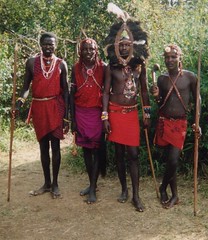 The Maasai are an ethnic group of semi-nomadic people located in Kenya and northern Tanzania. They are among the best known of African ethnic groups, due to their distinctive customs and dress and residence near the many game parks of East Africa. I came across these four Maasai tribesmen in Nairobi National Park, Keyna.
The Maasai are an ethnic group of semi-nomadic people located in Kenya and northern Tanzania. They are among the best known of African ethnic groups, due to their distinctive customs and dress and residence near the many game parks of East Africa. I came across these four Maasai tribesmen in Nairobi National Park, Keyna.
Maasai DNA
Recent studies of Maasai DNA reveal a complex history of the Maasai people. In 2005, Elizabeth Wood, et al., sampled the Y-DNA of 26 Maasai tribesmen, and from this sample determined that 50% of the individuals had Y-DNA of Haplogroup E1b1b1 (M35), 27% had A3b2 (M13), 16% had E1b1a1 (M2), and 8% B2a (M150). An explanation of each, in the context of the history of the Maasai, follows.
Eastern Sudanic Ancestry
The largest Y-DNA found among the Maasai sample, E1b1b1, represents Eastern Sudanic ancestry (although it is also associated with certain other "Nilo-Saharan" populations). One would expect to see a high percentage of this haplogroup based on the fact that the Maasai speak a Nilotic (Eastern Sudanic) language. However, based on the fact that only 50% of their DNA is Eastern Sudanic, it would appear that the Maasai are remnants of an older culture whose language went extinct after prolonged contact and interbreeding with Nilotic peoples. Examining the other components of their Y-DNA is the key to understanding the origin of the Maasai.
Niger-Congo Ancestry
Haplogroup E1b1a1 represents a component of the Masaai ancestry common among most Sub-Saharan populations, indicating Niger-Congo ancestry. The most likely source of this haplogroup is the Bantu expansion, whereby Bantu-speaking peoples spread across Sub-Saharan Africa from East to West, generally. However, this haplogroup does not reveal the ancient origin of the Masaai people.
Pygmy and Khoisan Ancestry
It would appear that prior to the Bantu expansion and the southward migration of the Nilotic peoples, the Maasai were a combination of Pygmy and Khoisan people, assuming that haplogroup B is the African Pygmy modal haplogroup and A3b is the Khoisan or "Bushman" modal haplogroup. The deep components of Masaai DNA suggest an admixture between the most divergent branch of the Pygmies and the most divergent branch of the Khoisan. Most Pygmy populations exhibit a significant percent of the B2b clade, whereas the Maasai exhibit the B2a sister clade. Most Khoisan peoples exhibit a significant percent of the A3b1 clade, whereas the Maasai exhibit the A3b2 sister clade. It would appear that the distant ancestors of the early Maasai (excluding recent Supra-Saharan admixture) were a mixture of members of two ancient African hunter-gatherer cultures. The spread of Nilotic and Bantu culture wiped out the entire language families of the component populations, although the Maasai maintained much of their ancient nomadic culture.
Maasai DNA Reveals Origins of Sandawe People
Until recently, the Sandawe people, although living in Tanzania, were considered to be closely related to the Khoisan ethnicities of the Kalahari desert. Much of this presumption was based on the fact that like the Kalahari Bushmen, the Sandawe speak a click language. However, in 2007, Sarah Tishkoff, et al., conducted a study on the Y-DNA of 68 Sandawe people. The results were more complicated than even the Maasai. However, excluding the 56 individuals who tested for Supra-Saharan Y-DNA (Eastern Sudanic and Niger-Congo haplogroups described above), the remaining 12 individuals exhibited 72% haplogroup B2b (M112), 22% haplogroup A3b2 (M13) and 6% B2a (M150). Note the 22:6 ratio of A3b2 to B2a, comprared with the nearly identical 27:8 ratio among the Maasai. This suggests that the Sandawe were originally B2b pygmies, with subsequent admixtures from (not necessarily in this order) the Maasai, Bantus and Nilotics. Unlike the Maasai, however, the Sandawe retained their ancient click language. Since the Hadza people of Tanzania are the nearest B2b click-speaking tribe, one could presume that the language of the Sandawe is distantly related to the Hadza language, both languages perhaps descending from a common language spoken by the original Pygmy who underwent the B2b Y-DNA mutation. That would mean that the only extant "true" A3b1 Khoisan languages are those click-languages spoken in and around the Kalahari desert.
Implications Beyond Sub-Saharan Africa
According to the most recently accepted version of the mt-DNA phylogenetic tree, it is believed that the first split occurred separating the Khoisan L0 clade from the L1-6 superclade (representing the founding populations of the speakers of all non-Khoisan languages). In the non-Khoisan superclade (represented by haplogroup BT in the Y-DNA phylogenetic tree), the first node appears to separate the African Pygmies from the ancestor of the speakers of all non-Khoisan and non-pygmy languages. This split corresponds to the split between B and CT in the Y-DNA tree. It is interesting that both the haplogroup A Khoisan languages and the haplogroup B Pygmy languages are click languages, and that CT (which is downstream from BT) is the only clade originating in this time period not dominated by click languages. This is some evidence, although not conclusive, that there may have been at one time a Proto-World language that had clicks among its sound inventory, ancestral to all modern languages, including the CT languages (including Enlgish, for example). That is to say, perhaps around 75,000-100,000 years ago, all languages had clicks, and the Supra-Saharan CT branch lost its clicks. An analogy would be the English language having lost grammatical gender despite its Indo-European origin.
References
History of Click-Speaking Populations of Africa Inferred from mtDNA and Y Chromosome Genetic Variation. Tishkoff, Sarah A. et al 2007.
Contrasting patterns of Y chromosome and mtDNA variation in Africa: evidence for sex-biased demographic processes. Wood, Elizabeth T et al 2005.
No comments:
Post a Comment